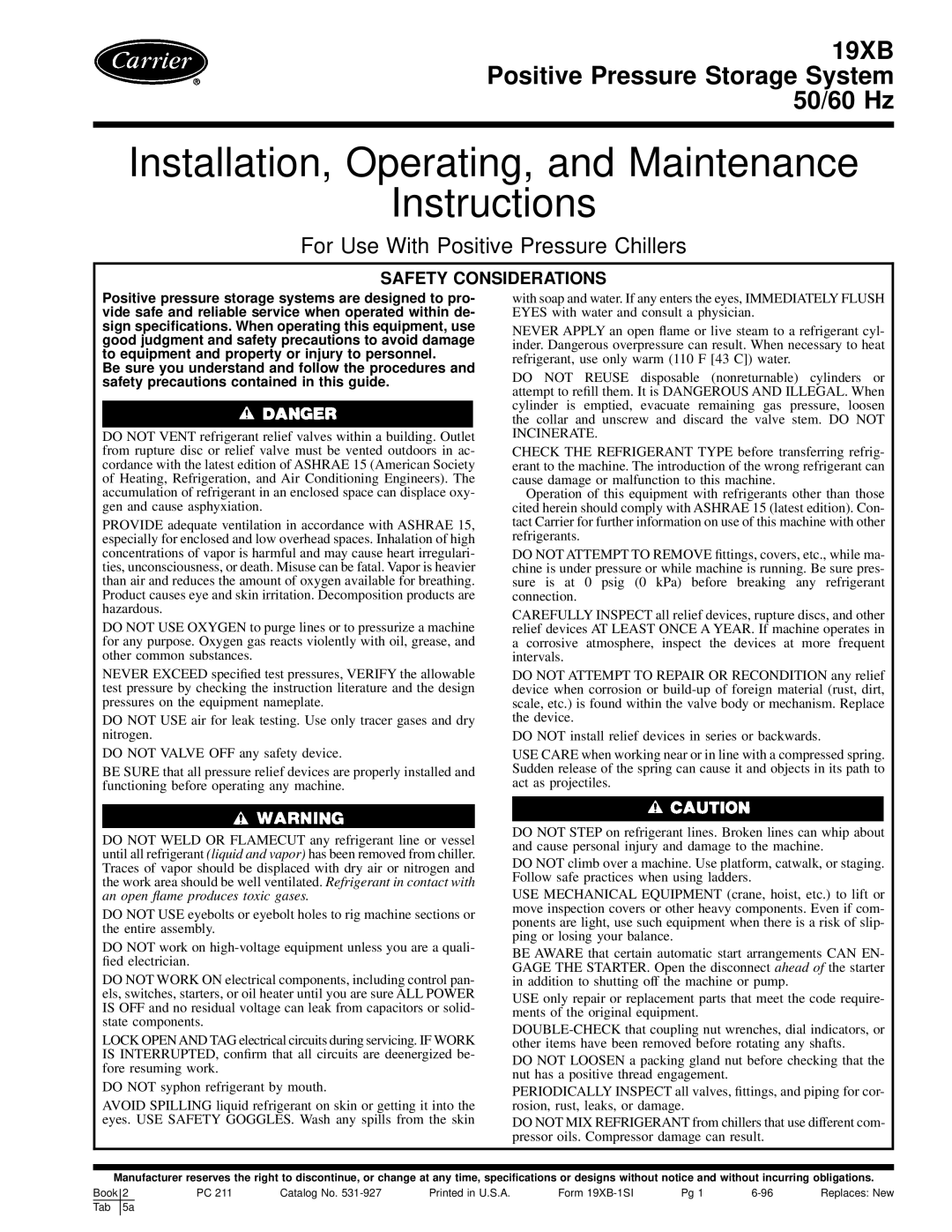
19XB Positive Pressure Storage System 50/60 Hz
Installation, Operating, and Maintenance
Instructions
For Use With Positive Pressure Chillers
SAFETY CONSIDERATIONS
Positive pressure storage systems are designed to pro- vide safe and reliable service when operated within de- sign speci®cations. When operating this equipment, use good judgment and safety precautions to avoid damage to equipment and property or injury to personnel.
Be sure you understand and follow the procedures and safety precautions contained in this guide.
DO NOT VENT refrigerant relief valves within a building. Outlet from rupture disc or relief valve must be vented outdoors in ac- cordance with the latest edition of ASHRAE 15 (American Society of Heating, Refrigeration, and Air Conditioning Engineers). The accumulation of refrigerant in an enclosed space can displace oxy- gen and cause asphyxiation.
PROVIDE adequate ventilation in accordance with ASHRAE 15, especially for enclosed and low overhead spaces. Inhalation of high concentrations of vapor is harmful and may cause heart irregulari- ties, unconsciousness, or death. Misuse can be fatal. Vapor is heavier than air and reduces the amount of oxygen available for breathing. Product causes eye and skin irritation. Decomposition products are hazardous.
DO NOT USE OXYGEN to purge lines or to pressurize a machine for any purpose. Oxygen gas reacts violently with oil, grease, and other common substances.
NEVER EXCEED speci®ed test pressures, VERIFY the allowable test pressure by checking the instruction literature and the design pressures on the equipment nameplate.
DO NOT USE air for leak testing. Use only tracer gases and dry nitrogen.
DO NOT VALVE OFF any safety device.
BE SURE that all pressure relief devices are properly installed and functioning before operating any machine.
DO NOT WELD OR FLAMECUT any refrigerant line or vessel until all refrigerant (liquid and vapor) has been removed from chiller. Traces of vapor should be displaced with dry air or nitrogen and the work area should be well ventilated. Refrigerant in contact with an open ¯ame produces toxic gases.
DO NOT USE eyebolts or eyebolt holes to rig machine sections or the entire assembly.
DO NOT work on
DO NOT WORK ON electrical components, including control pan- els, switches, starters, or oil heater until you are sure ALL POWER IS OFF and no residual voltage can leak from capacitors or solid- state components.
LOCK OPEN AND TAG electrical circuits during servicing. IF WORK IS INTERRUPTED, con®rm that all circuits are deenergized be- fore resuming work.
DO NOT syphon refrigerant by mouth.
AVOID SPILLING liquid refrigerant on skin or getting it into the eyes. USE SAFETY GOGGLES. Wash any spills from the skin
with soap and water. If any enters the eyes, IMMEDIATELY FLUSH EYES with water and consult a physician.
NEVER APPLY an open ¯ame or live steam to a refrigerant cyl- inder. Dangerous overpressure can result. When necessary to heat refrigerant, use only warm (110 F [43 C]) water.
DO NOT REUSE disposable (nonreturnable) cylinders or attempt to re®ll them. It is DANGEROUS AND ILLEGAL. When cylinder is emptied, evacuate remaining gas pressure, loosen the collar and unscrew and discard the valve stem. DO NOT INCINERATE.
CHECK THE REFRIGERANT TYPE before transferring refrig- erant to the machine. The introduction of the wrong refrigerant can cause damage or malfunction to this machine.
Operation of this equipment with refrigerants other than those cited herein should comply with ASHRAE 15 (latest edition). Con- tact Carrier for further information on use of this machine with other refrigerants.
DO NOT ATTEMPT TO REMOVE ®ttings, covers, etc., while ma- chine is under pressure or while machine is running. Be sure pres- sure is at 0 psig (0 kPa) before breaking any refrigerant connection.
CAREFULLY INSPECT all relief devices, rupture discs, and other relief devices AT LEAST ONCE A YEAR. If machine operates in a corrosive atmosphere, inspect the devices at more frequent intervals.
DO NOT ATTEMPT TO REPAIR OR RECONDITION any relief device when corrosion or
DO NOT install relief devices in series or backwards.
USE CARE when working near or in line with a compressed spring. Sudden release of the spring can cause it and objects in its path to act as projectiles.
DO NOT STEP on refrigerant lines. Broken lines can whip about and cause personal injury and damage to the machine.
DO NOT climb over a machine. Use platform, catwalk, or staging. Follow safe practices when using ladders.
USE MECHANICAL EQUIPMENT (crane, hoist, etc.) to lift or move inspection covers or other heavy components. Even if com- ponents are light, use such equipment when there is a risk of slip- ping or losing your balance.
BE AWARE that certain automatic start arrangements CAN EN- GAGE THE STARTER. Open the disconnect ahead of the starter in addition to shutting off the machine or pump.
USE only repair or replacement parts that meet the code require- ments of the original equipment.
DO NOT LOOSEN a packing gland nut before checking that the nut has a positive thread engagement.
PERIODICALLY INSPECT all valves, ®ttings, and piping for cor- rosion, rust, leaks, or damage.
DO NOT MIX REFRIGERANT from chillers that use different com- pressor oils. Compressor damage can result.
Manufacturer reserves the right to discontinue, or change at any time, speci®cations or designs without notice and without incurring obligations.
Book | 2 |
| PC 211 | Catalog No. | Printed in U.S.A. | Form | Pg 1 | Replaces: New | |
Tab | 5a |
|
|
|
|
|
|
| |
|
|
|
|
|
|
|
|
|
|
